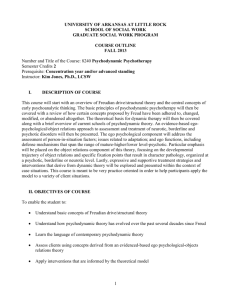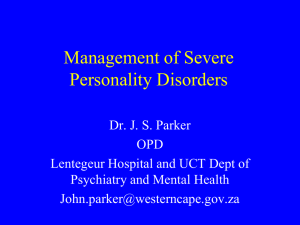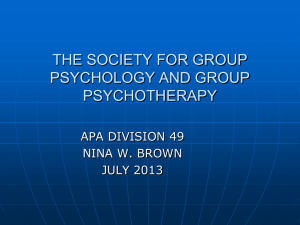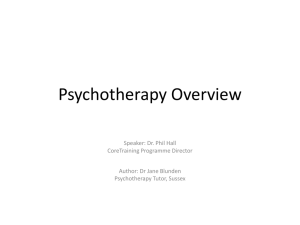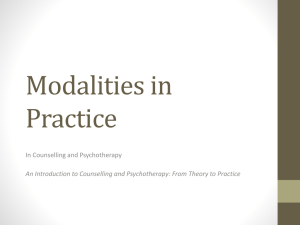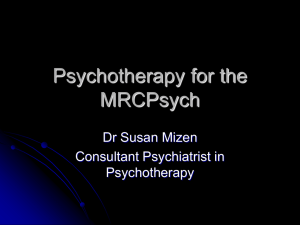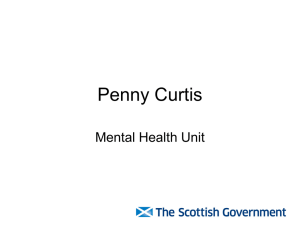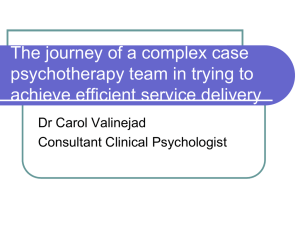Psychodynamic psychotherapy
advertisement
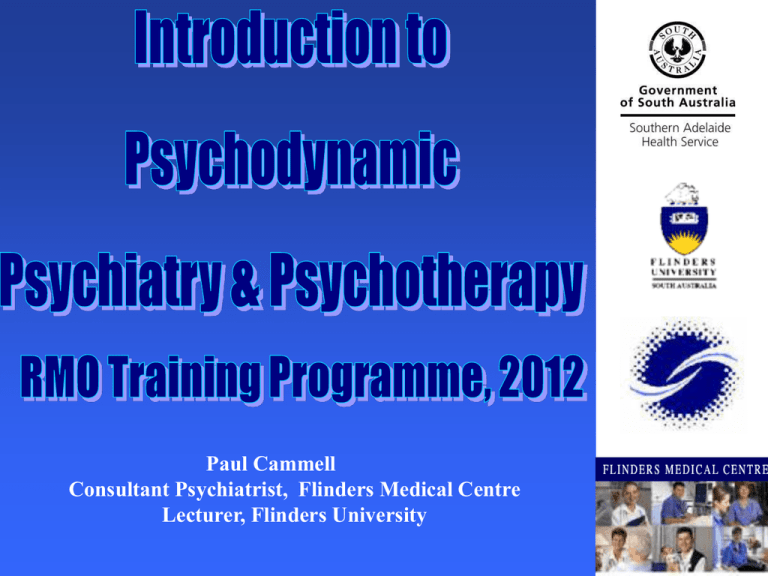
Paul Cammell Consultant Psychiatrist, Flinders Medical Centre Lecturer, Flinders University Psychodynamically informed practice 1. Discussion of cultural context: Australian psychotherapeutic culture (psychiatric and other) 2. Discussion of psychodynamic theories – relevance to your training and practice in general * Toolbox of concepts *Recommended Readings 3. Three Lectures: Prof Kalucy, Dr Paul Cammell and Dr Robin Chester Psychoanalytic Psychotherapy: -processes: transference, interpretation, resistance, enactment, etc -analytic triangles Malan--of person/conflict -models: classical, object relations, self psychology, ego psychology, relational, interpersonal, intersubjective, attachment orientation, mentalization, Lacanian, etc -training (theoretical, clinical supervision, training analysis, infant observation) Ranges of modalities adopted by psychiatrists: Formal psychoanalysis, psychoanalytic psychotherapy, psychodynamic psychotherapy, insight-oriented psychotherapy, psychodynamicallyinformed psychiatric management Conflicts with the era of managed care, health insurance funds, evidence based medicine, health management, time-limited, cost efficient approaches Role of Psychotherapy Outcomes Research Universal Techniques • Focus on affect and expression of emotion • Exploration of attempts to avoid distressing thoughts and feelings • Identification of recurring themes and patterns • Developmental focus – exploration of past experiences • Focus on interpersonal relations • Focus on the therapeutic relationship • Exploration of wishes and fantasies Classical Freudian Technique • • • • Transference Interpretation Dreams, Parapraxes Conflict and Defence Remembering, repeating, working through… Nachtraglichkeit Transference • Freud, S. (1912). The Dynamics of Transference. The Standard Edition of the Complete Psychological Works of Sigmund Freud, Volume XII (1911-1913): The Case of Schreber, Papers on Technique and Other Works, 97-108. • Freud, S. (1914). Remembering, Repeating and Working-Through (Further Recommendations on the Technique of Psycho-Analysis II). The Standard Edition of the Complete Psychological Works of Sigmund Freud, Volume XII (1911-1913): The Case of Schreber, Papers on Technique and Other Works, 145-156. • Klein, M. (1952). The Origins of Transference. Int. J. Psycho-Anal., 33:433-438. • Strachey, J. (1969). The Nature of the Therapeutic Action of Psychoanalysis. Int. J. Psycho-Anal., 50:275-292 • Winnicott, D.W. (1956). On Transference. Int. J. Psycho-Anal., 37:386388 Object Relations and British Independent or Middle Tradition • Klein: pre-Oedipal development, the paranoid-schizoid and depressive positions, envy, mourning • Bion: containment and alpha-beta function, psychotic personality • Winnicott, holding, transitional phenomena, false self • Balint, Fairbairn etc Ego Psychology, Neofreudian approaches • Ego defenses • Countertransference • Heimann, P. (1950). On Counter-Transference. Int. J. Psycho-Anal., 31:81-84 • Bion, W. R. (1967b), Notes on memory and desire, Psychoanalytic Forum, 2, 271-286 • Sandler, J. (1976). Countertransference and RoleResponsiveness. Int. R. Psycho-Anal., 3:43-47 ERIKSON’S EIGHT STAGES OF THE LIFE CYCLE Trust versus Mistrust (Birth to Approximately 18 Months) Autonomy versus Shame and Doubt (Approximately 18 Months to Approximately 3 Years) Initiative versus Guilt (Approximately 3 Years to Approximately 5 Years) Industry versus Inferiority (Approximately 5 Years to Approximately 13 Years) Identity versus Role Confusion (Approximately 13 Years to Approximately 21 Years) Intimacy versus Isolation (Approximately 21 Years to Approximately 40 Years) Generativity versus Stagnation (Approximately 40 Years to Approximately 60 Years) Integrity versus Despair (Approximately 60 Years to Death) Defense Mechanisms Narcissistic-Psychotic Defenses Projection Denial Distortion Splitting Immature Defenses Acting out Blocking Hypochondriasis Introjection Passive-aggressive behavior Projection Regression Schizoid fantasy Somatization Adapted from Vaillant GE. Adaptation to Life. Boston: Little Brown; 1977; Semrad E. The operation of ego defenses in object loss. In: Moriarity DM, ed. The Loss of Loved Ones. Springfield, IL: Charles C Thomas; 1967; and Bibring GL, Dwyer TF, Huntington DS, Valenstein AA. A study of the psychological principles in pregnancy and of the earliest mother–child relationship: Methodological considerations. Psychoanal Stud Child. 1961;16:25. Neurotic Defenses Controlling Displacement Dissociation Externalization Inhibition Intellectualization Isolation Rationalization Reaction formation Repression Sexualization Mature Defenses Altruism Anticipation Asceticism Humor Sublimation Suppression Defense mechanisms Adapted from Vaillant GE. Adaptation to Life. Boston: Little Brown; 1977; Semrad E. The operation of ego defenses in object loss. In: Moriarity DM, ed. The Loss of Loved Ones. Springfield, IL: Charles C Thomas; 1967; and Bibring GL, Dwyer TF, Huntington DS, Valenstein AA. A study of the psychological principles in pregnancy and of the earliest mother–child relationship: Methodological considerations. Psychoanal Stud Child. 1961;16:25. Attachment Theory Bowlby: Attachment and Loss Trilogy Evolutionary science, Ethology Grief, Privation, Deprivation (Maternal) attachment figure and security Internal Working Models Attachment (Proximity seeking) Separation (Anxiety, Anger) Loss (Sadness, Depression) Questions ? Recommended Readings Self Psychology • Heinz Kohut • Narcissism, Self pathology • Self cohesion, shame, mirror/twin and other transferences Kernberg •Ego Psychology and Object Relations •Borderline Personality •Transference Focussed Psychotherapy and the Evidence-Based Paradigm Interpersonal, Relational Approaches • Ogden, Sullivan, Mitchell, Aron, Stolorow, Orange, Bromberg • The authority of the patient, coconstruction and the analytic third • Context, prejudice, the return of dissociation, focus on trauma, existential, humanistic and hermeneutic approaches Lacan • The French and Latin-American psychotherapy cultures • Theory, Philosophy and Psychotherapy • The Three Orders, Linguistics, Structuralism Borderline Personality Disorder “The Problem Patient of Our Time” Borderline Personality and developmental neuroscience Giovanni Liotti: Disorganized Attachment and Borderline PD Peter Fonagy et al.: Mentalization as a core construct Russell Meares: Memory, frontal/pre-frontal function Glen Gabbard: Mind-body interactions – HPA axis, hippocampal volume, hemispheric lateralization Allan Schore: Right Brain Development and affective regulation Borderline Syndromes – History 1. Psychoanalysis – – 2. 1930s-1950s Stern, Knight 1960s-1970s Kernberg, (Winnicott, Khan, Bergeret) Psychiatry • • • • 1940s-1960s Ambulatory Schizophrenia (Zilboorg), “Preschizophrenia” (Rapaport), “latent schizophrenia” (Federn), “pseudoneurotic schizophrenia” (Hoch and polatin), “schizotypal disorder” (Rado) Late 1960s “Borderline states” (Knight), “Borderline Syndrome” (Grinker) Mid 1970s “Borderline Personality” (Gunderson et al.) 1980 DSM III “Borderline Personality Disorder” Modern “evidence-based” psychotherapy 3. – – – 1970s-1990s Object Relations BasedTransference Focussed Psychotherapy (Kernberg, Clarkin) 1990s Dialectical behaviour Therapy (Linehan); “Mentalization-based treatment” (Fonagy, Bateman, Target) 1990s-present Cognitive Analytic Therapy (Ryle), Conversational Model (Meares), Supportive Psychoanalytic Psychotherapy (Appelbaum), Schema-Focused Therapy and Systems Training for Emotional Predictability and Problem Solving (or “STEPPS”, Blum) Modern Therapeutic Approaches • Pharmacotherapy – HPA axis sensitization and anxiolytic medication (eg atypical antipsychotic medications) – Serotonergic agents • Psychotherapy – Dialectical Behaviour Therapy (Linehan) – Psychodynamic psychotherapy • Mentalization-based (Fonagy, Bateman, Target et al.), • Object-Relations based (Kernberg) • Self-Psychology based (Meares) – Other structured, crisis plans, patient responsive, limit setting, team-based Mentalization • Theory of mind (Fonagy, Bateman, Target et al.), social biofeedback theory, “mentalized affectivity” • Borderline Personality Disorder— psychic equivalence and pretend modes; splitting and dissociation; disorganized trauma responses; affect dysregulation Giovanni Liotti and Attachment Disorders • Ethology/evolutionary research: motivational systems (and IWM’s) – eg care-seeking, care-giving, sexual—pair bonding, ranking— dominance/submission, egalitarian/altruistic, intersubjective • Attachment Disorganization and psychopathology – borderline and antisocial PD, conduct disorder, emotional dysregulation and impulse control problems (HPA Hyperresponsiveness) • Transgenerational transmission – The Adult Attachment Interview Mentalization • Theory of mind (Fonagy, Bateman, Target et al.), social biofeedback theory, “mentalized affectivity” • Borderline Personality Disorder— psychic equivalence and pretend modes; splitting and dissociation; disorganized trauma responses; affect dysregulation Borderline Personality and “abuse” or “trauma” Judith Herman: Complex PTSD “sexual abuse” ERS Nijenhuis, Onno van der Hart: Psychotraumatology and Dissociative Disorder Questions ? Case for Next Week Recommended Readings Recommended Readings: General texts, including evidence based reviews: New Oxford Textbook of Psychotherapy (Gabbard, Beck, Holmes) What works for whom, Roth & Fonagy Standards and Guidelines for the Psychotherapies (Paul Cameron, Jon Ennis & John Deadman Eds) eg Chapter 3 Basic Approaches to Psychodynamic Psychotherapy: David Malan (Individual Psychotherapy and the Science of Psychodynamics), Glen Gabbard (Psychodynamic Psychiatry), Nancy McWilliams (Psychoanalytic Psychotherapy: A Practitioner’s Guide), Psychodynamic Diagnostic and Statistical Manual Models and Theories: Comprehensive Textbook of Psychiatry (Kaplan & Sadock), Chapters 6 and 30
